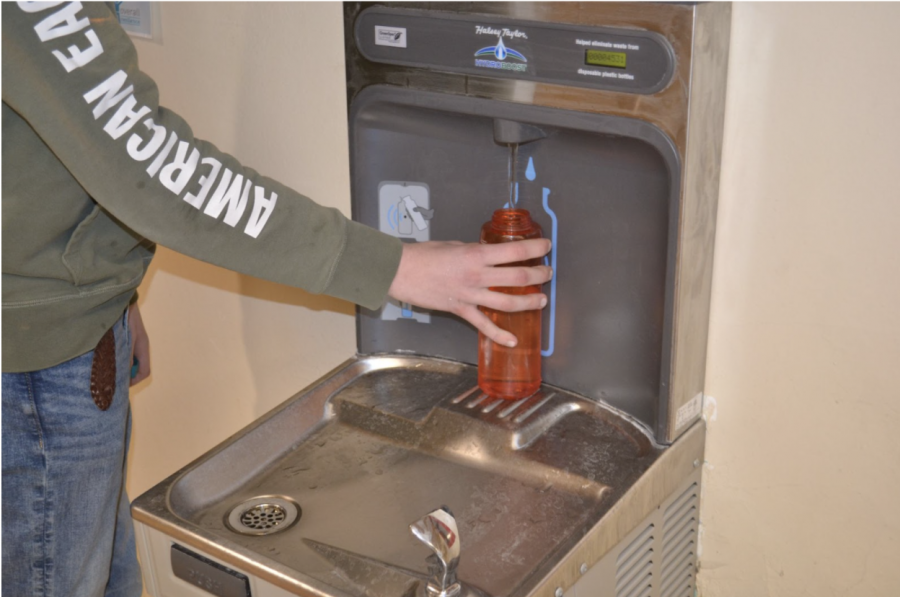One bottle at a time
Insight into the high school’s water bottle refilling stations
Water Wellness: A student utilizes the school’s water bottle dispensers to refill during the day. Alex Brouhard, psychology teacher, said, “Dehydration can have an adverse effect on our moods, how we think, and our energy levels.” Photo illustration by: Max Kiernan.
January 10, 2022
You’ve probably noticed at one point or another that above several of the water fountains throughout the building, is a second water fountain – only this one is for bottles. As it dispenses water into your bottle, it ticks up a visible counter on the machine for each generic plastic water bottle worth of water you take.
Using fewer plastic bottles is by all means a great practice to participate in, and the data shows the student body and faculty certainly do. During a two-week period between the four tallied dispensers, an average of 44 plastic bottles are saved via the appliance and its use daily.
But how do students feel about the dispensers and seeing the display change as they help the environment?
“It’s weirdly satisfying, and I always watch the counter while I fill up my water bottle,” Lillian Oehlers (11) said.
Another important factor to consider is their convenience within our classrooms.
“I always like to have water accessible to me throughout the day.” Ella Pleiman (11) said.
Comparing the amount of bottles the school as a whole saves with our total student body population puts these metrics into perspective.
“It feels great – our school made a great decision implementing a system that could help us more easily fill water bottles and I also feel like I’m contributing by using them,” Grace Stafford (10) said.
With more than half of all U.S. teenagers being chronically dehydrated according to the CDC, some who don’t drink an abundance of water on a daily basis should think about carrying a bottle with them, and filling them up throughout the school while they’re at it.
Psychology teacher and cross country coach Alex Brouhard elaborated on the effects of dehydration on the brain.
“Dehydration can have an adverse effect on our moods, how we think, and our energy levels,” Brouhard said. ”Every cell, tissue and organ in our body needs water to work properly – for athletes, proper hydration improves recovery, minimizes injuries and cramping, and maximizes performance.”
Brouhard says, however, that athletic performance is not the only performance determinant found from a lack of water intake.
“I think most people understand that proper hydration is key to athletic performance, however, most students probably don’t consider proper hydration something vital to academic performance. Studies have shown that when our brains don’t get enough water, our neurons are more active than normal while performing cognitive tasks. This means that our brains have to work harder to engage in class,” Brouhard said.
Seems like an important aspect of your health. But how much should you drink to maintain hydration?
“Most people have heard that 8 glasses of water a day should be a target. If you are drinking less than that, you should try to increase your water intake. The amount of water individuals should drink varies depending on body weight, exercise level, and other factors. The U.S. National Academies of Sciences, Engineering, and Medicine determined that an adequate daily fluid intake is about 15.5 cups (3.7 liters) of fluids a day for men, and about 11.5 cups (2.7 liters) of fluids a day for women.” Brouhard said.
With all of these benefits, you’d think that dehydration would be less of a problem.
Brouhard said, “I think it’s interesting how something so simple, and often taken for granted, but also essential in our survival, can impact our day-to-day lives.”
















